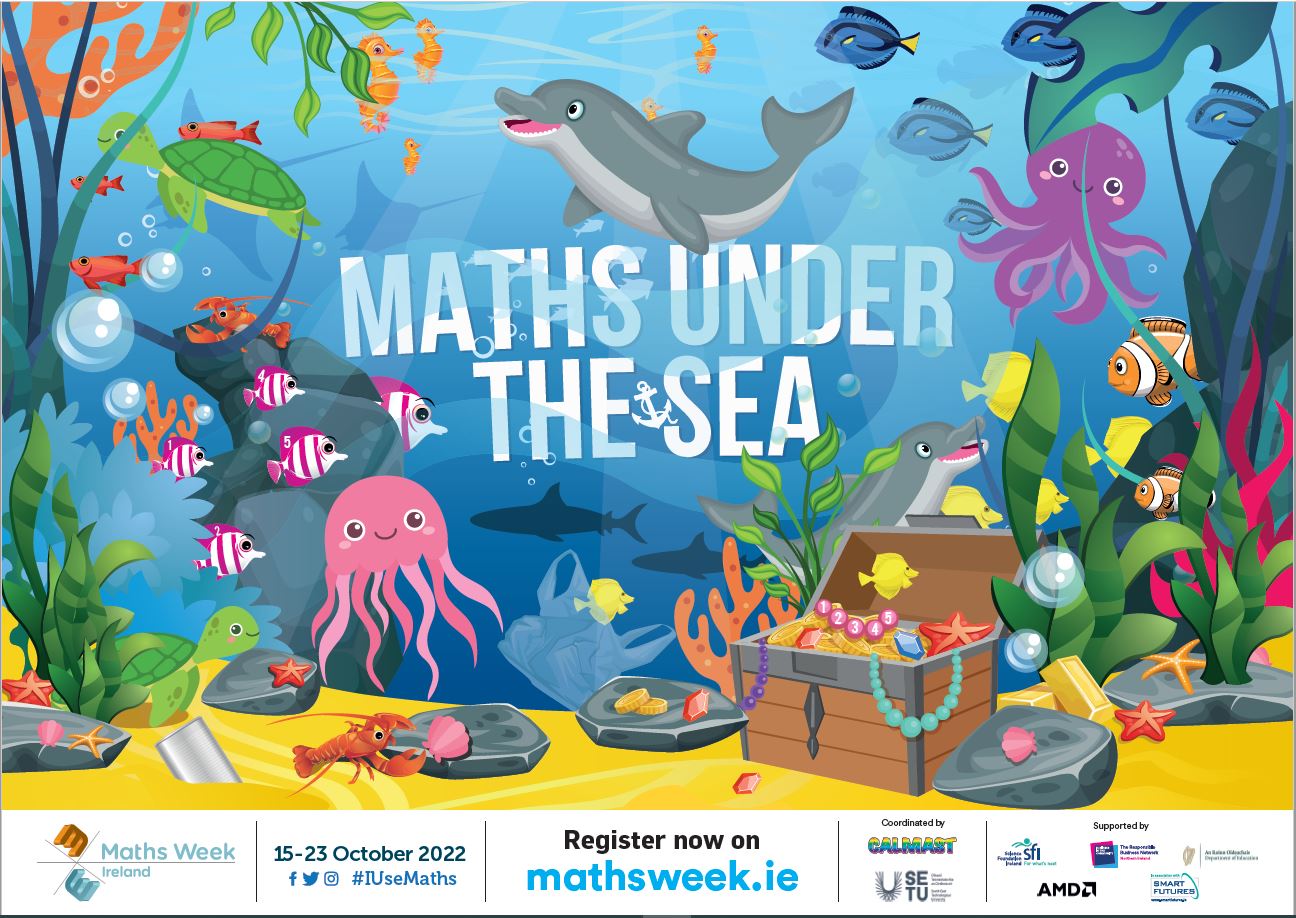Exploring Maths Under The Sea
Maths Under The Sea- Poster activity
(Special Thanks to Margaret Donegan for devising these activities)
Introduction
(Although listed as Introduction, these can be used again and again to develop and practise skills)
- Let’s have a look at the poster and think about what we see
- Allow 2-3 minutes for children to look at the poster individually. If necessary, remind them ‘Thinking is quiet. First let’s think about what we see, then we’ll share’.
- In pairs, take turns telling your partner what you see in the picture. Try not to repeat something your partner has said.
Each time you tell something new that you see, take a counter from the pile in the centre and add it to your (shared)tower. Each partner uses a different coloured cube. If you cannot see anything new, say ‘Pass’, and your partner continues. - During this time the teacher should try not to prompt by asking questions, but encourage children who are stuck by thinking aloud.
- Group all the children with their towers. Comment on the height of each tower, to focus on height (measures) or on how many cubes are in each tower, to focus on numbers.
- Ask each pair in turn to tell one thing they saw. Acknowledge any others who saw/listed the same item. As a child names one item, They take one cube off the tower and return it to the centre pile. Each pair who saw/mentioned the same thing does the same. Continue until all towers have been depleted.
- At a later stage, if reasonably proficient writers, might be asked to list what they see in writing, either individually or as pairs, with each partner using a different coloured pencil.
You can use this poster to explore maths with children. Playing games with children will help them develop a positive attitude towards maths. This can help develop mathematical thinking such as counting, comparing, sorting and spatial relations. Here are some suggestions:
Counting: How many of each creature can you see? How many striped fish can you find?
Matching: Can you find sea creatures that are the same?
Comparing: For example, are there more Dolphins or Starfish?
Numbers and Numerals:
Can you see any numbers on the poster? Where?
What numbers can you see?
There are some numbers printed. What are they?
Find the odd numbers.
Find the even numbers.
Show me the number that comes before 5. What
is it?
Show me the number that comes between 3 and
5. What is it?
Show me the number that is 2 less than 4. What is
it?
Show me the number that is 3 more than 1. What
is it?
Construction/ Art and Craft / Creativity:
Can you construct this scene at home or at
school?
It does not need to be exactly the same but it
should have the main elements. Perhaps you
have ideas of things that can be added.
Work by yourself or with a friend or group.
What will you use as the background? Perhaps a
box to make a diorama, or a page to make a
collage or picture.
What can you use to make the fish? Can you
make different sizes, types and colours of fish?
How will you make seaweed? Will all your
seaweed look the same, or will they be different?
Will you add any people figures? Perhaps a diver,
a pirate, an explorer or a mermaid.
Spatial Awareness – Measures Talk about the creatures. Which ones are Colourful / Short / Long / Big / Small.
Can you see a creature that is longer / shorter / bigger / smaller than a chosen example?
Spatial Awareness – Positional Language: Talk about where different object are. For instance behind the seaweed / above another creature,/etc.
Ask where a particular creature is located. Children must tell where the creature is by using positional language. For example using above / between / behind / on the left/ at the top /etc.
Describe where a particular animal is and ask the children to identify it. For example, “I’m thinking of a creature. It is behind a bubble. “

Click the image for the poster
Some learning points (impossible to list them all!)
- Vocabulary development
- Sentence structure – encourage the use of the sentence stem ‘I see ……’
- Thinking skills (EG The first time a child may say ‘I see numbers’ but on subsequent occasions may decide to say ‘I see number 1/ I see number 2 etc or ‘I see odd numbers / I see even numbers))
- Observation, attention to detail
- Turn taking
- Patterning
- Listening skills (as you listen to each other and then the whole group retell what they saw)
- Memory (as you recall what has been said so as not to repeat)
For the full teacher’s guide to these activities by Margaret Donegan you can download the powerpoint below!
